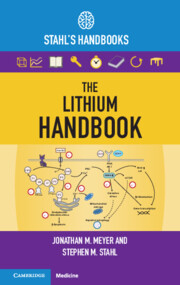Book contents
- The Lithium Handbook
- Reviews
- The Lithium Handbook
- Copyright page
- Contents
- Foreword
- Preface: How to Use This Handbook
- Introduction
- 1 The Efficacy Story
- 2 Renal Handling of Lithium
- 3 Clinical Pharmacokinetics
- 4 Lithium Initiation and Monitoring
- 5 Management of Routine Lithium Related Adverse Effects
- 6 Lithium Toxicity
- 7 Special Populations and Circumstances
- 8 Lithium Discontinuation
- Index
- References
Introduction
Published online by Cambridge University Press: 09 February 2024
- The Lithium Handbook
- Reviews
- The Lithium Handbook
- Copyright page
- Contents
- Foreword
- Preface: How to Use This Handbook
- Introduction
- 1 The Efficacy Story
- 2 Renal Handling of Lithium
- 3 Clinical Pharmacokinetics
- 4 Lithium Initiation and Monitoring
- 5 Management of Routine Lithium Related Adverse Effects
- 6 Lithium Toxicity
- 7 Special Populations and Circumstances
- 8 Lithium Discontinuation
- Index
- References
Summary
As reflected in the number of citations per year, the initial golden age of lithium discovery was indeed 1965–1990. Yet interest in lithium has not waned, and a renaissance in lithium related publications has occurred over the past 20 years (Figure 0.1). This literature is fueled by ongoing exploration of lithium’s unique mood stabilizing, anti-suicide and neuroprotective properties, a constellation of activities not seen in any single molecule [1–10]. Delving into how a simple ion conveys such benefits has opened important avenues of research into the neurobiology of both mood and degenerative brain disorders, and the molecular neuropharmacology of intracellular G-protein dependent and G-protein independent 2nd messenger systems [11, 12].
- Type
- Chapter
- Information
- The Lithium HandbookStahl's Handbooks, pp. 1 - 23Publisher: Cambridge University PressPrint publication year: 2023

